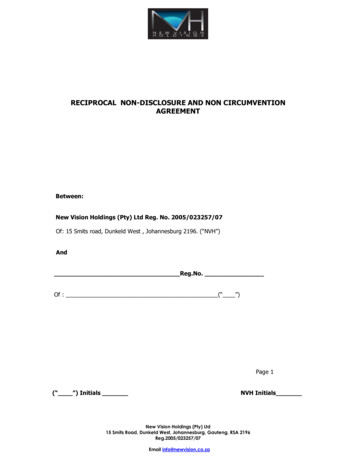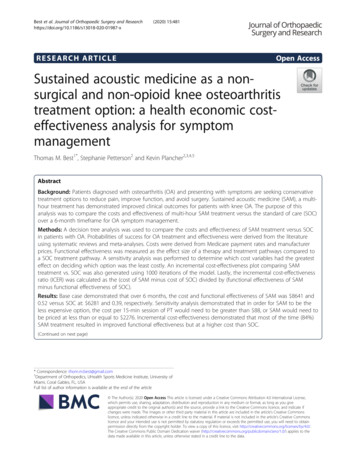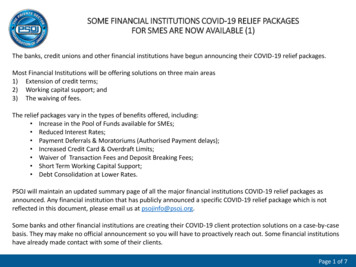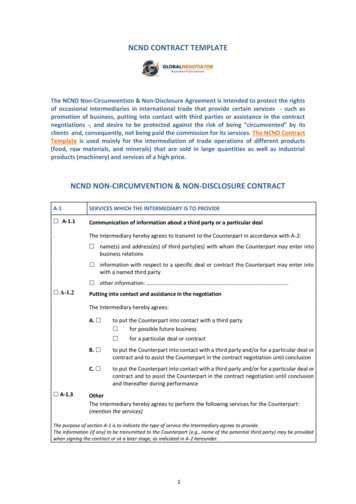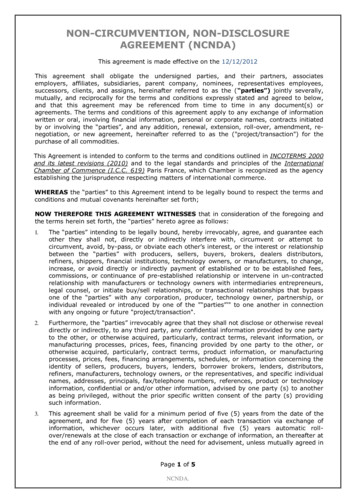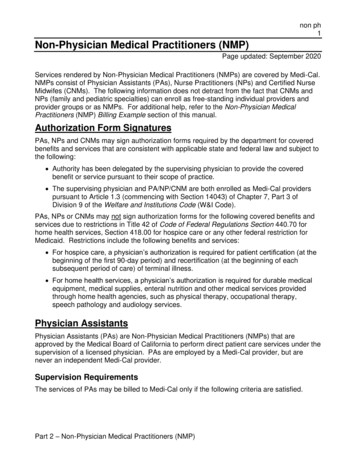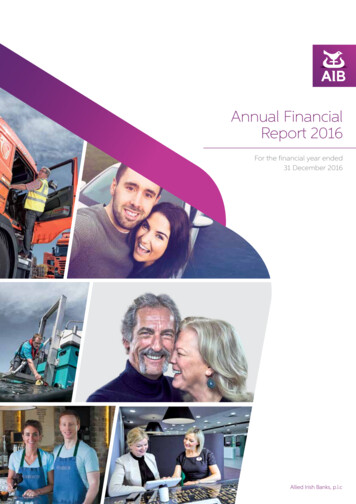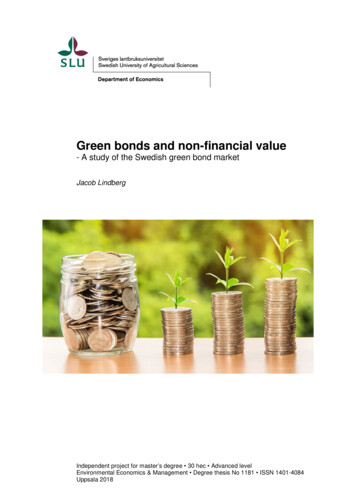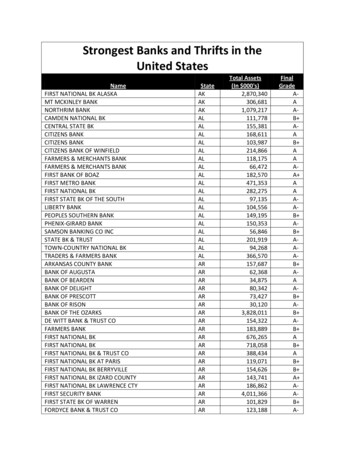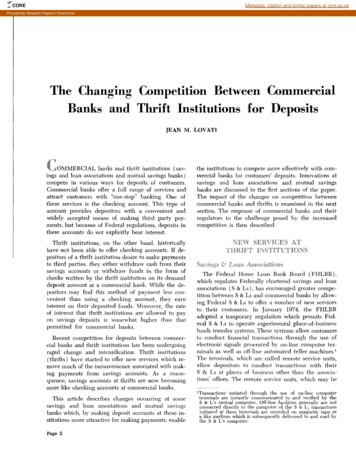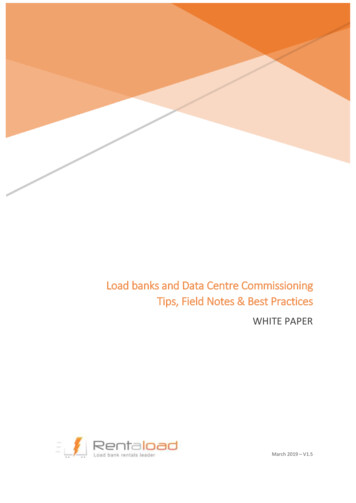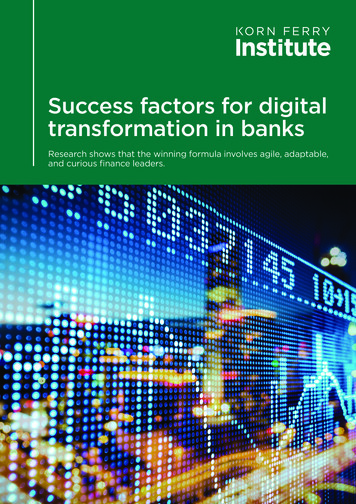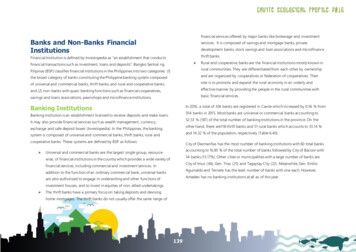
Transcription
financial services offered by major banks like brokerage and investmentBanks and Non-Banks FinancialInstitutionsservices. It is composed of savings and mortgage banks, privatedevelopment banks, stock savings and loan associations and microfinancethrift banks.Financial Institution is defined by Investopedia as “an establishment that conducts financial transactions such as investment, loans and deposits”. Bangko Sentral ngRural and cooperative banks are the financial institutions mostly known inrural communities. They are differentiated from each other by ownershipPilipinas (BSP) classifies financial institutions in the Philippines into two categories: (1)the broad category of banks constituting the Philippine banking system composedand are organized by cooperatives or federation of cooperatives. Theirof universal and commercial banks, thrift banks, and rural and cooperative banks;role is to promote and expand the rural economy in an orderly andand (2) non-banks with quasi-banking functions such as financial cooperatives,effective manner by providing the people in the rural communities withsavings and loans associations, pawnshops and microfinance institutions.basic financial services.In 2016, a total of 356 banks are registered in Cavite which increased by 0.56 % fromBanking Institutions354 banks in 2015. Most banks are universal or commercial banks accounting toBanking institution is an establishment licensed to receive deposits and make loans.52.53 % (187) of the total number of banking institutions in the province. On theIt may also provide financial services such as wealth management, currency,other hand, there are118 thrift banks and 51 rural banks which accounts to 33.14 %exchange and safe deposit boxes (Investopedia). In the Philippines, the bankingand 14.32 % of the population, respectively (Table 6.40).system is composed of universal and commercial banks, thrift banks, rural andcooperative banks. These systems are defined by BSP as follows: City of Dasmariñas has the most number of banking institutions with 60 total banksaccounting to 16.85 % of the total number of banks followed by City of Bacoor withUniversal and commercial banks are the largest single group, resource-54 banks (15.17%). Other cities or municipalities with a large number of banks arewise, of financial institutions in the country which provides a wide variety ofCity of Imus (46), Gen. Trias (25) and Tagaytay City (22). Meanwhile, Gen. Emiliofinancial services, including commercial and investment services. InAguinaldo and Ternate has the least number of banks with one each. However,addition to the function of an ordinary commercial bank, universal banksAmadeo has no banking institutions at all as of this year.are also authorized to engage in underwriting and other functions ofinvestment houses, and to invest in equities of non-allied undertakings. The thrift banks have a primary focus on taking deposits and devisinghome mortgages. The thrift banks do not usually offer the same range of139
Table 6.40 Number of Bangko Sentral ng Pilipinas Supervised Banks by City/Municipality, Province of Cavite: 2015 and 2016City/Municipality byDistrictUniversal/Commercial Banks20152016Thrift Banks2015st1 District303017Cavite City994Kawit554Noveleta115Rosario151542nd District232523City of Bacoor2325233rd District252414City of Imus2524144th District333518City of Dasmariñas3335185th District222419Carmona11124Gen. Mariano Alvarez347Silang8886th District252818AmadeoCity of General Trias13165Tanza557Trece Martires City7767thDistrict202114Alfonso1Gen. Emilio AguinaldoIndang2MagallanesMaragondon1Mendez (Mendez-Nuñez)1Naic663Tagaytay City14156TernateTotal178187123Source: Financial Institution Library System (FILS), Bangko Sentral ng Pilipinas, Pasay City140Rural 6466060491812195202513144831412311221356
Non-Bank Financial InstitutionsNon-bank financial institutions (NBFIs) are financialinstitutions that do not have a full banking license butfacilitate bank-related financial services, such asinvestment, risk pooling, contractual savings and marketbrokering. Only NBFIs with quasi-banking functions(NBQBs) and those without quasi-banking function butare subsidiaries and affiliates of banks and NBQBs aresubject to BSP supervision. NBQBs are financial institutionsauthorized by BSP to borrow funds from 20 or morelenders for their own account through issuances,endorsement or assignment with recourse or acceptanceof deposit substitutes for purposes of re-lending orpurchasing receivables and other obligations.As of 2016, non-bank financial institutions in Cavitetotaled to 823 institutions of which 821 are NBFIs withoutQuasi-Banking Function wherein most of them arepawnshops that account to 99.76 % of the total NBFIswithout quasi-banking function. Most NBFIs are located atthe City of Dasmariñas which has 147 institutions thatcontributes 17.88 % of the population of NBFIs. It isfollowed by City of Bacoor and Imus with 139 and 132institutions, respectively (Table 6.41).Table 6.41 Number of Bangko Sentral ng Pilipinas Supervised Non-Bank FinancialInstitutions by City/Municipality Province of Cavite: 2015 and 2016NBFIs without Quasi-Banking FunctionCity/Municipality byDistrictNon-StockFinancingSavings and LoanCompaniesAss’n201620152016 2015 201620151st District1461310044Cavite City595444Kawit3839Noveleta1916-Rosario30222nd District1401390000City of Bacoor1401393rd District1221291111City of Imus12212911114th District1611460100City of Dasmariñas16114615th District99890000Carmona1718Gen. Mariano Alvarez3027Silang52446th District1041040000Amadeo1City of General Trias5046Tanza3841Trece Martires City15177thDistrict82760000Alfonso67Gen. Emilio AguinaldoIndang118Magallanes11Maragondon45Mendez (Mendez64Nuñez)Naic2929Tagaytay City2320Ternate22Total8548141255Source: Financial Institution Library System (FILS), Bangko Sentral ng Pilipinas, Pasay City141PawnshopsNBFIs 5429202823
Automated Teller Machine NetworkTable 6.42 Geographical Distribution of Automated Teller Machines(ATMs) by City/Municipality, Province of Cavite: 2016.Automated Teller Machine (ATM) is an electronic channel that provides bankCity/Municipality by DistrictOn-Site Off-Site Total% DistributionTotal360457817Universal and Commercial Bank29740770486.17GroupBank GroupThrift554810312.61Rural and Cooperative Bank82101.22st DistrictGroup1646713116.03Cavite 2245678.202 nd District446611013.46City of Bacoor446611013.463 rd District458713216.16City of Imus458713216.164 th District699116019.58City of Dasmariñas699116019.585 th District49408910.89Carmona2219415.02Gen. Mariano Alvarez146202.45Silang1315283.436 th District545811213.71Amadeo2130.37City of General Trias2534597.22Tanza138212.57Trece Martires City1415293.557 thDistrict35488310.16Alfonso00.00Gen. Emilio ndon110.12Mendez (Mendez-Nuñez)110.12Naic104141.71Tagaytay City2136576.98Ternate00.00Total360457817Source: Systems and Reports Management Division (SRMD), Supervisory Data Center BangkoSentral ng Pilipinas, Pasay Citycustomers an alternative method of doing their financial transactions in a publicarea without the assistance of a human clerk or bank teller. The customer identifieshimself by inserting the ATM card which has his card number and other securityinformation, and by entering his Password Identification Number (PIN). As a formof electronic money, the ATM card can be used to buy things much like a creditcard, but minus the interest on spending since it debits from the cardholder’sexisting account. It is also safer, more convenient, and has no real cost to thecardholder.In 2016, Cavite has 817 ATMs wherein 360 of these are located in the bank premisesand 457 are off-site or in malls and other establishments. Moreover, most ATMsbelong to universal and commercial banks which have a total of 704 ATMs thatmakes up to 86.17 % of the total number of ATMs. Thrift bank group has 103 totalATMs while rural and cooperative bank group has only 10 ATMs. It can be observedfrom the data given that the most numbers of ATMs are located in the cities inCavite (Table 6.42).142
Foreign Exchange Dealers, Money Changers,and Remittance AgentsTable 6.43 Number of Foreign Exchange Dealers (FXD), Money Changers(MC) and Remittance Agents (RA) by City/MunicipalityProvince of Cavite: 2016Foreign Exchange Dealer (FXD) is a type of financial institution that has receivedauthorization from a relevant governing body to act as a dealer involved with theCity/Municipality by District FXD/MC FXD/MC/RARATOTAL1 st District8474297Cavite City5152141Kawit112518Noveleta24410Rosario1612282 nd District156762144City of Bacoor1567621443 rd District375360150City of Imus3753601504 th District115670137City of Dasmariñas1156701375 th District6383680Carmona18918Gen. Mariano Alvarez111526Silang51912366 th District12404799Amadeo0City of General Trias7162346Tanza2141531Trece Martires City3109227 thDistrict15353484Alfonso1236Gen. Emilio Aguinaldo0Indang347Magallanes0Maragondon3216Mendez (Mendez-Nuñez)224Naic113822Tagaytay City10121638Ternate11Total104336351791Source: Financial Institution Library System (FILS), Bangko Sentral ng Pilipinas, Pasay Citytrading of foreign currencies. Dealing with authorized foreign exchange dealersensure that the transactions are being executed in a legal and just way.Remittance Agents (RAs) refer to persons or entities that offer to remit, transfer ortransmit money on behalf of any person to another person and/or entity. Theseinclude money or cash couriers, money transmission agents, remittance companiesand the like – BSP Circular No 471, Section 1, as amended . Local remittance agents,including money changers (MCs) and pawnshops are considered non-bank financialinstitutions, and are regulated and governed by the Bangko Sentral ng Pilipinas(BSP) through the Manual of Regulations for Non-Bank Financial Institutions(MORNBFI). Before they can start operation, they are required to register with theBSP first. And before they can register with the BSP, they are required to beregistered or to apply registration with other government offices, like the DTI, SEC(for partnerships and corporations), and the local government unit (LGU) or Mayor’soffice.As of 2016, Cavite has 791 foreign exchange dealers, money changers ansremittance agents. Most of these are found in cities wherein City of Imus has themost number of facilities registering to 791 institutions. It is followed by cities ofBacoor and Dasmariñas with 144 and 137 institutions, respectively. It can beobserved that almost all cities/municipalities have at least one FXD, MC or RAexcept for Amadeo, Gen. Emilio Aguinaldo and Magallanes (Table 6.43).143
other hand, there are118 thrift banks and 51 rural banks which accounts to 33.14 % and 14.32 % of the population, respectively (Table 6.40). City of Dasmariñas has the
